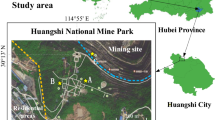Abstract
Toxic trace elements emitted during coal combustion are the main sources of air pollution. They are released into the atmosphere mainly in the forms of fine ash, smoke and flue, and thus adversely affect plant, animal and human health. Selenium is one of toxic and the most volatile in coal. Large amount of atmospheric emission of selenium, as well as selenium present and scrubber stockpiles in ash may create serious environmental problems. In the paper, on the basis of investigating the abundance and distribution of selenium in plant-rings during recent 20 years, the bioaccumulation of selenium is explained that selenium in plant, which were collected from the village of selenium-rich coal combustion, is much higher than that in plants collected away from the village of selenium-rich coal combustion. The main origins of selenium are selenium-rich coal combustion and high-selenium rock weathered. The selenium recycle by food chain and selenium will accumulate and redistribute in environments.
Similar content being viewed by others
References
Cheng, J. (1980).The Preliminary investigation report selenium intoxication inZiyang county of Shanxi Province, Shanxi. Agricultural Science, 6, 17 (in Chinese).
Clarke, L. B, & Sloss, L. L. (1992). Trace elements from coal combustion and gasification (p. 111). London: IEA Coal Research, (IEACR/49).
Finkelman, R. B., Palmer, C. A, Krasnow M. R., Aruscavage P. J., Sellers G. A., & Dulong, F. T. (1990). Combustion and leaching behaviour of elements in the argonne premium coal samples. Energy & Fuels, 4(6), 766–767.
Huang, Y., Jin, B., Zhong, Z., Xiao, R., Tang Z., & Ren, H. (2004). Trace elements (Mn, Cr, Pb, Se, Zn Cd and Hg)in emissions from a pulverized coal boiler. Fuel Processing Technology, 86, 23–32.
Liu, G., Zhang, H., Yang, P., & Peng, Z. (2004). Volatility of trace elements and characterization of ash at different coal combustion temperatures. Proceedings of the 3rd International Symposium on Heat Transfer and Energy Conservation, 1, 375–380.
Liu, G., Zhang, Y., Qi, C., Zheng, L. (2006a) An assessment of emission and environmental impact to health and pig of selenium in selenium-rich coal combustion from Yutangba, Hubei, China. Sciences of the total environmental. (in reviewing).
Liu, G., Zheng, L., Duzgoren-Aydin, N. S., & Gao, L. (2006b). Toxic trace elements As, F and Se in Chinese indoor coals combustion and their health implications. Reviews of Environmental Contamination and Toxicology, 189, 89–106.
Su, H., Yan, L., Rao, S., Jian, X., & Mao, D. (1990). Investigation of the cause of the origination of the environmental selenium area in the Exi autonomous prefecture of Hubei province. Environmental Science, 11(2), 86–89.
Sun, J., & Jervis, R. E. (1986). Distribution characterization of trace elements during coal combustion[J]. China Science Bulletin (A), 16, 1285–1294.
Wang, Q., Kang, S., Chen, C., Wang, Z., & Zou, S. (1996). Study on the contents and distribution laws of trace elements in coal in Northeast China and Eastern inner Mongolia. Environmental Chemistry, 15(1), 27–35. (in Chinese with English Abstract).
Yang, G. Q, Zhou, R. H., Sun, S. Z., & Wang, S. Z. (1981). Research on the etiology of an endemic disease characterized by loss of nails and hair in English County. Journal of Chinese Academic Medicine, 3 (suppl. 2), 1–6 (in Chinese with English abstract).
Yang, G. Q., Wang, S. Z., Zhou, R. H., & Sun, S. Z. (1983). Endemic Selenoum intoxication of humans in China. The American Journal of Clinical Nutrition, 37, 872–881.
Zheng, B., Ding, Z., Huang, R., Jianming, Z., Xiaoying, Y., Aimin, W., et al. (1999). Issues of health and disease relating to coal use in southwestern China[J]. International Journal of Coal Geology, 40, 119–132.
Zheng, B. S., Hong, Y., Zhao, W., Zhou, H., Xia, W., Su, H., et al. (1992). Endemic selenium intoxication and selenium-rich carbonaceous silicate in western Hubei Province. Science Bulletin, (11), 1027–1029.
Zheng, B., & Huang, R. (1986). Prevention and cure and study of the fluorosis caused by pollution of domestic coal[J]. Journal of Practical Endemic Disease Study, 1(2), 11–13. (in Chinese with English Abstract).
Zheng, B., & Huang, R. (1989). Human fluorosis and environmental geochemistry in southwest China. Debelopments in geoscience contributions to 28th international geologic congress, Washington D. C. (pp. 171–176). Beijing, China: Science. (in Chinese).
Zhu, J., & Zheng, B. (2004). Distribution of selenium in a mini-landscape of Yutangba, Enshi, HUbei Province, China. Applied Geochemistry, 16, 1333–1344.
Zhu, J., Zuo, W., Liang, X., Li, S., & Zheng, B. (2004). Occurrence of native selenium in Yutangba and its environmental implications. Applied Geochemistry, 19, 461–467.
Author information
Authors and Affiliations
Corresponding author
Rights and permissions
About this article
Cite this article
Liu, G., Zhang, Y., Qi, C. et al. Comparative on Causes and Accumulation of Selenium in the Tree-rings Ambient High-selenium Coal Combustion Area from Yutangba, Hubei, China. Environ Monit Assess 133, 99–103 (2007). https://doi.org/10.1007/s10661-006-9563-4
Received:
Accepted:
Published:
Issue Date:
DOI: https://doi.org/10.1007/s10661-006-9563-4




